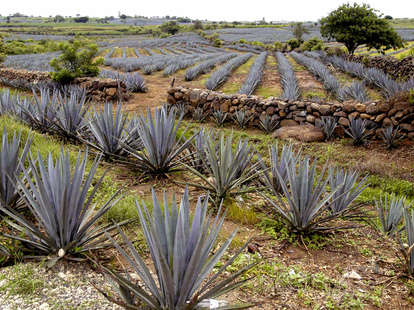Why Blue Weber Agave Is Different from All Other Agave

There are hundreds of varieties of agave growing in Mexico, including many used in the production of mezcal, but only one, blue Weber, may be used to make tequila. Even as the spirit’s sales grow massively in the U.S.—hitting $2.5 billion in American revenue in 2016 with no signs of stopping—distillers must rely on their supplies of this singular plant. A 1977 Mexican law (NORMA OFICIAL MEXICANA, NOM-006-SCFI-201) requires tequila makers to use blue Weber in accordance with the “Declaración de Denominación de Origen Tequila” or "Appellation of Origin Declaration," which specifies the region and methods for tequila production. Far from an arbitrary rule, the blue Weber variety earned its codified place in Mexican law for its taste and history.
Franz Weber, a German naturalist who classified agave species around the turn of the 20th century, gave his name to the species, but the history of the plant—also known by its latin name agave tequilana—goes back much further. Tania Oseguera, master tequilier for Tequila Cazadores, explains that Spaniards created the first agave distillate after conquering Mexico in the 16th century, creating mezcal from the fermented juice that Mexican natives drank. “The small town of Tequila was a natural habitat for the blue agave plant, so the locals used these plants to distill the drink known as ‘vino mezcal,’” she says. “It is important to note that the town of Tequila wasn't the only place to produce vino mezcal, but it soon became famous for producing the most delicious version of the drink. For this reason, many people began asking specifically for ‘vino mezcal de Tequila’—rather than ‘vino mezcal’—and later, for just ‘tequila.’” While harvesting and distillation of agave tequilana (and its appellation of origin) have spread beyond the immediate area surrounding the town, the name and the plant remain synonymous.
While Oseguera admits that various production methods among mezcal producers and differences in styles greatly confuse the task of isolating an agave variety’s specific flavor, blue Weber does differentiate itself from the pack with a particularly sweet flavor. “Other varieties are popularly known for having more intense herbal notes, like salmiana and tobalá agaves, while others are known for being sweet and earthy, like espadín, or earthy and dry, like cuishe,” she explains. “The cooked blue agave juice has a very sweet flavor that I would compare to caramelized pumpkin with hints of citrus and tropical fruits.”
Setting aside blue Weber’s effects on the taste of the bottled spirit, the variety is also relatively easy to cultivate, an important factor in a rapidly expanding industry facing environmental and market hurdles. “Blue agave and espadín are strong varieties which are easy to cultivate and have ‘short’ maturation times—from 5 to 9 years—compared to wild agaves which can take from 9 to 12 years to mature,” Oseguera says. Not only is the variety fast growing, but it also contains lots of sugars, which speed up cooking time during tequila production. “Blue agaves are also known for having high concentrations of sugar which can vary from 25 to 30 sugar reductors.” She points to a study in the Mexican Journal of Agricultural Sciences that found agaves used in mezcal like espadín and cuishe came close to blue agave at 21 sugar reductors and 27 reductors respectively, but varieties with larger piñas that take longer to cook, like salmiana, have lower concentrations of sugar.
What began as a single town that created remarkable mezcal from local blue agave has transformed into a massive enterprise covering five Mexican states. The high demand for blue agave has taken a toll on the both the environment and tequila producers, but it remains both the only legal and sensible choice for distillers due to its fast growing time, high concentration of sugar and recognizable tradition. Oh, and it tastes pretty good too.